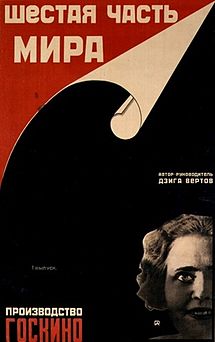- A Sixth Part of the World
-
A Sixth Part of the World 
Directed by Dziga Vertov Produced by Kultkino, Sovkino Written by Dziga Vertov Cinematography Mikhail Kaufman Editing by Elizaveta Svilova, Dziga Vertov Distributed by Sovkino Release date(s) December 31, 1926[1] (USSR) Running time 73 minutes Country Soviet Union Language Silent film
Russian intertitlesBudget SUR 80 000 A Sixth Part of the World (Russian: Шестая часть мира, Shestaya Chast Mira), sometimes referred to as The Sixth Part of the World, is a 1926 silent film directed by Dziga Vertov and produced by Kultkino and Sovkino. Through the travelogue format, it depicted the multitude of Soviet peoples in remote areas of USSR and detailed the entirety of the wealth of the Soviet land. Focusing on Soviets diversity, the film is in fact a call for unification in order to build a "complete socialist society". A mix between newsreel and found footage, Vertov edited sequences filmed by eight teams of kinoks (or kinokis) during their trips. According to Vertov, the film anticipates the coming of sound films by using a constant "word-radio-theme" in the intertitles.[2]Thanks to A Sixth Part of the World and his following feature The Eleventh Year (1928), Vertov matures his style in which he will excel in his most famous film Man with a Movie Camera (1929).
Contents
Vertov's intentions
In an interview for Kino magazine in August 1926, Vertov explained his intentions : "A Sixth Part of the World is more than a film, than what we have got used to understanding by the word ‘film.’ Whether it is a newsreel, a comedy, an artistic hit-film, A Sixth Part of the World is somewhere beyond the boundaries of these definitions; it is already the next stage after the concept of ‘cinema’ itself … Our slogan is: All citizens of the Union of the Soviet Socialist Republics from 10 to 100 years old must see this work. By the tenth anniversary of October there must not be a single Tungus who has not seen A Sixth Part of the World” (quoted in Barbara Wurm’s essay in the DVD booklet)[3]
Production
At the beginning of 1918, Dziga Vertov was hired to edit the newsreel Kinonedelia ("Cine week") for the Moscow Cinema Committee. With no formal education in the editing science, he learnt to build coherent newsreel with a minimun of stock. Practising editing on different kind of short movies, Vertov began to theorize his own view on editing. It's in the hope to put in practice his theories that he formed in 1922 the first "kinoki" group ("Cine-Eyes") in which he began to issue the Kinopravda (Cine-truth) serie of films. At that time, Vertov published essays in specialized publications detailing his theories on cinema. In 1924, the Goskino film production set up a documentary section called Kultkino and Vertov was place in charge. In 1925, Gostorg the Central State Trading Organisation, was seeking a director for a film promoting internal trade and praising the merits of the new social order. A Sixth Part of the World will be a coproduction between Kultkino and Sovkino.[4]
Reception
The film was well received by the Pravda. Praising the film, the periodical Sovetskii ekran stated: "These films reveal to us that Russian cinematography has found the correct path".[5] However, prominent critics criticized it. Critic Viktor Shklovsky accused the film of being fiction in his article "The Cine-Eyes and Intertitles". According to critic Ippolit Sokolov, the movie is "deformation of facts done by montage". The film remained mostly unexploited by official propaganda and Vertov was expelled from Sovkino production in 1927, being accused of exceeding more than three times the initial budget of 40 000 roubles (the film will cost actually twice this budget).[6]
DVD Release
Editions Filmmuseum has released the film in 2009 in a 2-disc set with the film The Eleventh Year (1928).[1]
References
- ^ Leyda, Jay Kino: a history of the Russian and Soviet film, p. 432
- ^ Vertov, Dziga Kino-eye: the writings of Dziga Vertov, p. 91
- ^ Power, Nina. "Vertov's World". Film Quarterly 63 4 (2010). http://www.filmquarterly.org/2010/07/vertovs-world/. Retrieved 2011-06-29.
- ^ Roberts, Graham The man with the movie camera
- ^ Roberts, Graham Forward Soviet!: history and non-fiction film in the USSR, p. 49
- ^ Roberts, Graham The man with the movie camera, p. 25
External links
- A Sixth Part of the World at the Internet Movie Database
- A Sixth Part of the World at AllRovi
- A Sixth Part of the World at Mubi
- View Online on Google Video (Notes: bad quality video with esperanto subtitles)
Cinema of the Soviet Union (1917–1991) Films A-Z · Animation · Festivals · Studios · Actors · Cinematographers · Composers · Directors · Editors · Production designers · Screenwriters
Films by year: 1917–1921 · 1922 · 1923 · 1924 · 1925 · 1926 · 1927 · 1928 · 1929 · 1930 · 1931 · 1932 · 1933 · 1934 · 1935 · 1936 · 1937 · 1938 · 1939 · 1940 · 1941 · 1942 · 1943 · 1944 · 1945 · 1946 · 1947 · 1948 · 1949 · 1950 · 1951 · 1952 · 1953 · 1954 · 1955 · 1956 · 1957 · 1958 · 1959 · 1960 · 1961 · 1962 · 1963 · 1964 · 1965 · 1966 · 1967 · 1968 · 1969 · 1970 · 1971 · 1972 · 1973 · 1974 · 1975 · 1976 · 1977 · 1978 · 1979 · 1980–1991
Categories:- Soviet films
- 1926 films
- Soviet documentary films
- Russian-language films
- Black-and-white films
- Films directed by Dziga Vertov
- Silent films
- Soviet revolutionary propaganda films
- 1920s documentary films
Wikimedia Foundation. 2010.
